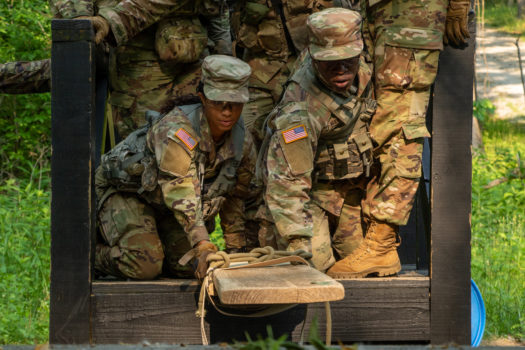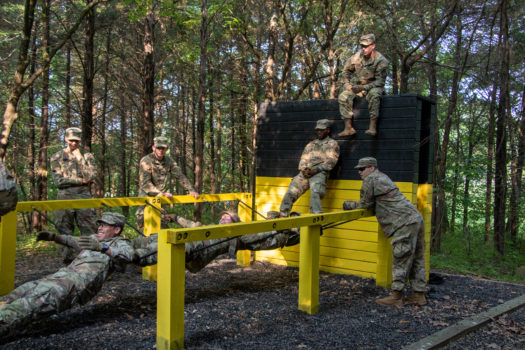Story by Madelyn Guinn and Jaden Whiteman

FORT KNOX, Ky. – The field leader reaction course is an obstacle course designed to challenge and strengthen the Cadets’ teamwork and critical thinking skills during Cadet Summer Training. With 12 different courses for them to complete, the Cadets split into equal teams, appoint a squad leader in each team to guide them through their obstacles and complete the task at hand within a certain amount of time.
U.S. Army Cadet Leila Enoch from the University of Rhode Island is in her third year of being a Cadet, so she has worked through courses like this at her university. After having been named squad leader during one of the courses, Enoch explained her thoughts and experiences during the FLRC training.
“I think it’s difficult because everybody in your group kind of has certain ideas about certain things that they should be doing for that lane, but it’s up to that one person to really bring everyone home,” said Enoch. “I actually got stumped a little bit when I was a leader during my lane, but I was able to take ideas from others and try to work with what I had and the equipment that we had to try to get as far as we could in the time allotted.”

One of the 12 courses that the Cadets are tasked to complete is the rope bridge. The rope bridge simulates a broken bridge above rushing water that all Cadets within the squad must cross then climb over a wall without touching the ground. Cadet Aiden Quigley of Montana State University described why he enjoyed that course.
“I really liked the one with the cables, and you have to get a box and your people over a wall. [There was] a lot of goofy positioning, and you are learning a lot about the physical capabilities of your teammates,” said Quigley.
Capt. Adriana Tarrago from the University of Maryland’s Reserve Officers’ Training Corps 4th Brigade is working as an observer-controller-trainer during CST, and she’s been here for only six days with her Cadets. She explains how the FLRC is important because it provides the Cadets the opportunity to assess their individual strengths and weaknesses while identifying what they need to work on as a team.
“I think this is a great experience to start off CST with because this is the first time that they’ve been put in a team together,” Terrago said. “It just allows them the opportunity to work through things together before getting assessed and moving on to other things.”

Cadet Seth Daniels from the University of Kansas was originally enlisted as active duty but joined the ROTC program to expand his skill set into an officer position.
“I really love these kinds of obstacles, like the critical thinking, putting the physical aspect into it, putting people in that leadership roles,” Daniels said. “I really enjoy it, and I love seeing people blossom.”




